I’m a sucker for a good supermarket display, which is why last week, I found myself captivated by a DIY plum wine (technically, it's a liqueur) display at Mitsuwa, a chain of Japanese markets. Unbeknownst to me, we’re in the season to make hooch out of unripened, tart green ume, a kind of apricot it turns out.
I’d only had commercially-made Japanese plum wine produced with a base of white wine, and it was good chilled. For the Saigon Silk cocktail on page 150 in The Pho Cookbook, we used Takara plum wine. What would homemade be like?
The little fruits (Prunus mume) are related to apricots but commonly referred to in English as a plum. The fruits are preserved and made into drinks and condiments in East Asia (e.g., traditional Chinese plum sauce is often made from the same fruits).
As Shizo Tsuji points out in his classic cookbook, ume doesn’t usually ripen well, falling off branches during the humid rainy season. For that reason, the green fruits arrive at Japanese markets in an unripen state so cooks can make good use of them. The season for green ume lasts from late May into June. When the fruit turns yellow, the ume are good for pickling and making umeboshi. The Japanese are specific about seasonality to make the best use of ingredients.
Mitsuwa's display included a recipe, bags of ume, packaged white rock sugar, and three sizes of glass containers for putting up the liqueur. I stood there for a while assessing my need/want to take the leap. A man and his daughter joined me at the display. I told him in English that Mitsuwa had an entire kit for making the liqueur. I handed him a recipe. Nodding, he responded in Mandarin, “Tamen hen congming.” (They are very smart.) We both laughed because we realized that other Asian markets are usually not as persuasive in efforts to make a seasonal sale.
At $7.99 a pound, the American-grown ume wasn’t cheap but I was game. I'd watched the plum liqueur segment of Midnight Diner: Tokyo Stories on Netflix. The plum liqueur played such a compelling role in the show – evoking emotional and gustatory reactions. My husband and I were both so taken by the segment and there were the ingredients! We had shochu at home but I wondered about why the recipe called for 1.75 liters. When I went to the liquor section, turns out there was an end cap display that included 1.75-liter boxed cartons of barley shochu for $22.99.
The market's recipe called for granulated sugar but its display included white rock sugar made of beet and cane sugar that looked a lot like Chinese rock sugar. I had Chinese yellow rock sugar at home and prefer its more complex flavor to that of white rock sugar so I passed on the stuff sold at the Japanese market. Rock sugar is not as sweet as granulated sugar. If you use regular sugar, use less, such as 1.25 pounds sugar for 2 pounds of ume plums.
I've made fruit liqueurs with regular granulated sugar and they were fine. The rock sugar, however, may create a rounder mouthfeel because it's a semi-refined sugar. It's the sugar that's used for making Saigon-style pho and other noodle soup broths. It's the sweetener for classic Chinese red-cooked dishes.
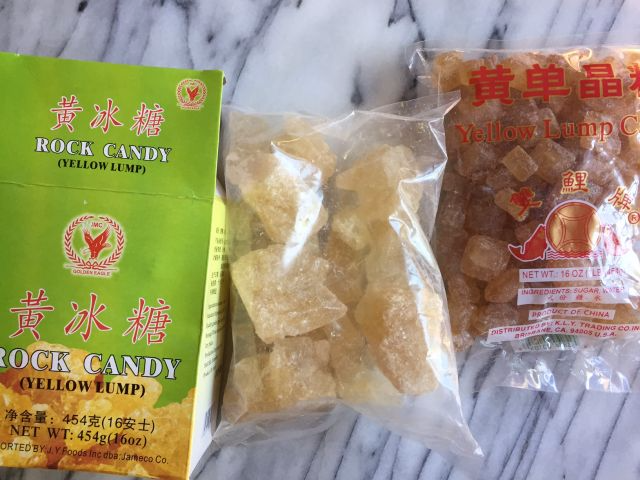
The shochu in the box was 20% alcohol. In Tsuji's Japanese Cooking, he suggests higher octane liquor – around 35 % alcohol, for his plum wine recipe. My shochu collection at home went as high as 25% so I decided to blend the 20% alcohol box shochu with 40% alcohol Polish vodka. My blend was 1.25 L shochu and 500 ml vodka. I didn't want the liqueur to lean too far toward Eastern Europe but I did want to skooch things up to roughly 30% alcohol.
The Mitsuwa flyer called for soaking the plums in water for 2 to 4 hours to prevent bitterness but Tsuji didn't require that step. I soaked them anyway for safety's sake, though nothing seemed to change in the water during the 3-hour soak. Afterward, I read on this Japanese recipe website that soaking is only required for plums destined for pickling. You can opt to not soak, as I indicate below.
Next came removing the stems and lingering flower bits from each plum. I used a skewer. You're supposed to layer the plums with the sugar in a squeaky clean/sterilized glass container then pour in the liquor. I split the ingredients between two containers since I didn’t have one big one. Then I capped it and slid it into a dark, cool spot – my hall closet.
It won't be ready for 3 months, if not a year. I plan on checking back with it around the holidays, around the fifth or sixth month mark. Some Japanese swoon over homemade plum wine. I hope I'll be doing that around Christmas.
Don't have ume nearby? Use hard, green apricots and back off the sugar since they’re not as sour as ume, says Tsuji. He also recommends quick versions using other tart fruit, sugar, and liquor. Berries are great and will be ready in about 10 days, he says.
Speaking of which, I've made Framboise this time of year from Paula Wolfert's recipe in The Cooking of Southwest France; it akes 1 month and requires combining the following in a jar: 1 pint firm-ripe raspberries, ¾ cups sugar, 1 ½ cups Armagnac. And here's a plum liqueur recipe that I made from a Bon Appetit magazine recipe.
So, there are 3 booze recipes for you to consider. There's great fruit coming into season now. Eat some but also invest time to preserve them for later.
Do you make boozy fruit liqueur? What kind? Or how do you like to enjoy yours?
RECIPE
Japanese Plum Wine
Umeshu
Yields: about 1.75 liters
Ingredients
- 2 pounds green, unripen ume
- 1 ½ pounds Chinese rock sugar, white or yellow
- About 1.75 liter shochu and/or vodka
Method
- If you like, soak the ume for 2 to 4 hours. Drain, then use a skewer or toothpick to remove the dark stem bits and other funny lingering parts from the belly-button end of each fruit.
- Layer the ume and sugar in two very clean (sterilize them, if you want) 2 to 3-quart containers. Add the liquor. Cap tightly then store in a cool dark place for at least 3 months. Strain to store and serve. The fruit is supposedly edible.
Pho excitement continues (it's a classic dish!). I was interviewed on Cherry Bombe radio while I was in New York. And Lilly Nguyen peppered me with questions for a pho segment on LOA Broadcasting.
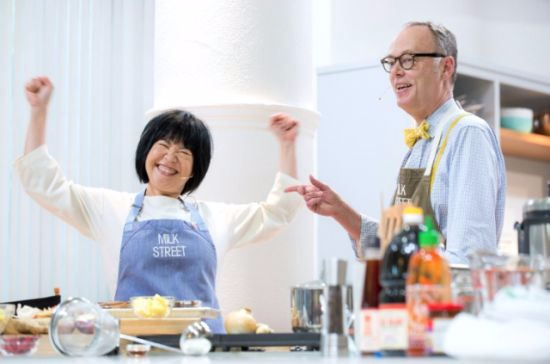













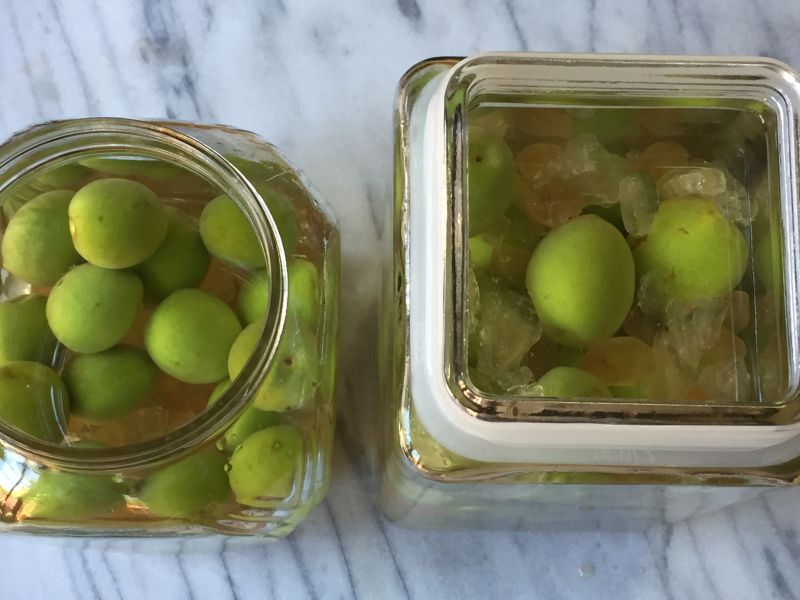
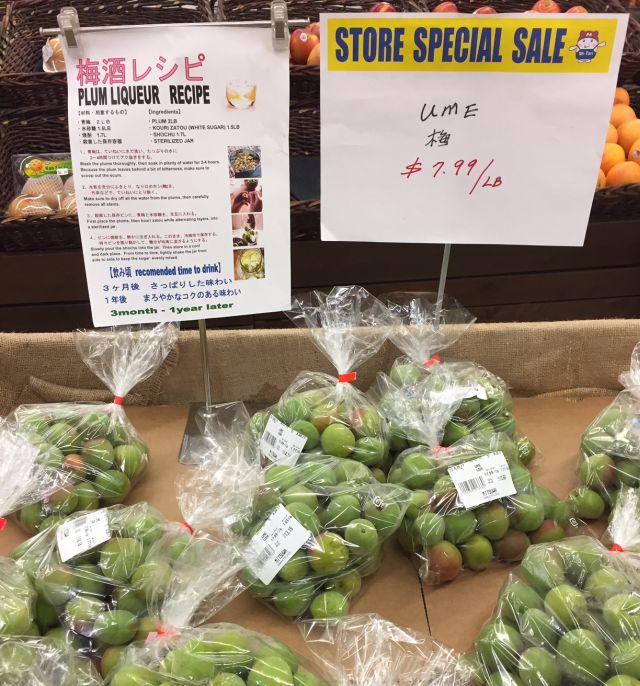

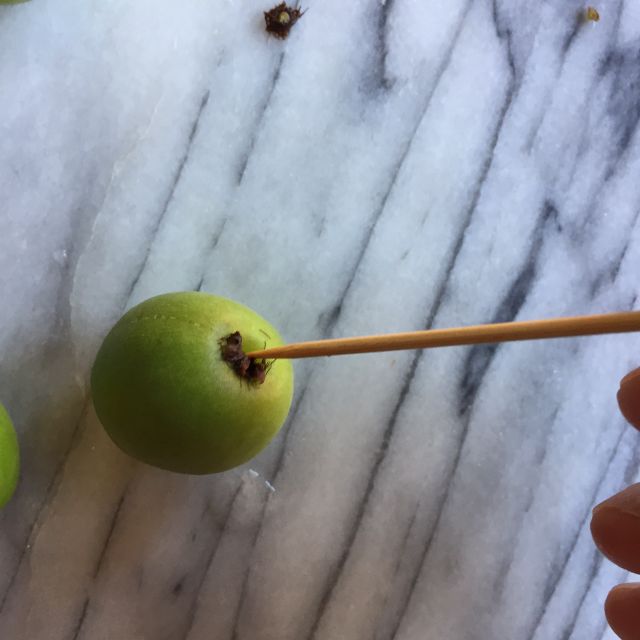
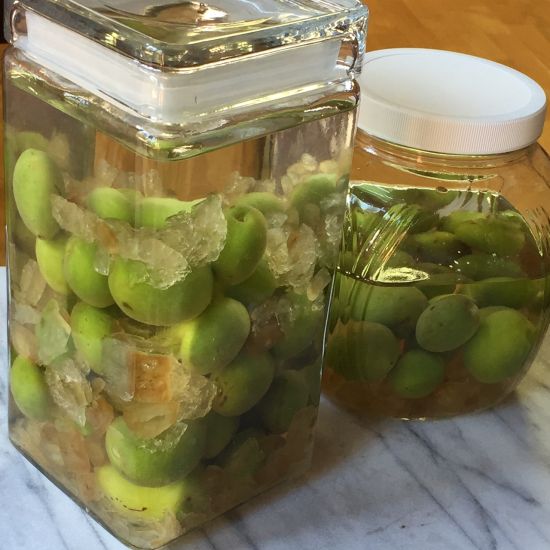




maryjane says
nice.
Greg says
This looks great. I live in eastern Washington state, and I just harvested the plums from my Prunus mume tree. It was actually supposed to be a flowering variety, with no fruit, but it has produced a large crop every year. This is the first year I will try making 梅酒. I had some homemade umeshu on a recent trip to Japan. It was delicious, so now I have to try it myself!
Andrea Nguyen says
You grow ume? Wow. The universe gave you a wonderful gift. I've been drinking the umeshu on ice as an aperitif. You will soon be doing the same!!!
John Brown says
We lived in Japan 5 years (back since May) and had 2 unexpected trees in our yard, but were late learning to make unexpected shy. It was a seasonal store display (5 liter jar) that got us started. It was easy and delicious and got better and better over a year. We now have 3 of these 5 liter jars but now need to find the use fruit and the white liqueur we used in Japan (I’d like to repeat that recipe).
How can I attach photos?
Andrea Nguyen says
In California, the ume is sold in June at markets like Mitsuwa. You can buy the liquor there too! You can link to a photo but there is no upload function in this commenting system.
You may grow ume too! https://www.forestfarm.com/prunus-mume-bongo-prmu074